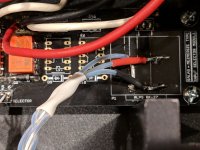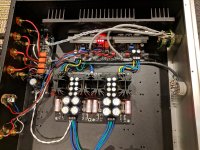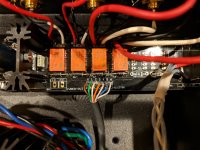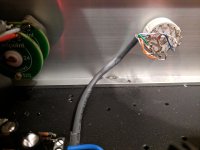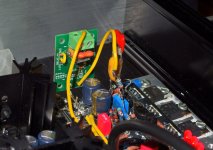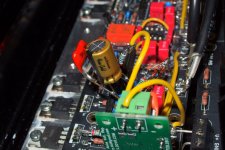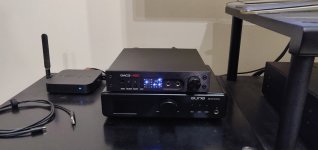Input selector and volume control connections at I select board.
Hello Russell. Here are some pics. I hope they help you.
Hello Russell. Here are some pics. I hope they help you.
Attachments
Salas DCG3 preamp (line & headphone)
Some progress to the above
Finally the LT3045 regulator boards have arrived.
LT3045-M Ultra Low Noise LDO Voltage</br>Regulator
I can recommend them as they are of a nice built, using good parts, and surely the designer has studied the AnalogDevice data sheet to get the best out of it.
This precision 15V low noise regulators now feed the first stage of Salas' HP board with a RC Filter of 150ohm / 100uF (Tant + MKT + silver MICA) in between.
The first stage draws basically a constant current and thus a series regulator followed by a hefty RC filter does not have any disadvantages or trade offs.
If one likes to give it a try:
- connect GND OUT of LT3045 board as close as possible to the Salas HP board GND IN
- do not connect GND IN of LT3045 board
- connect 100uF (Tant + MKT + silver MICA) of the RC filter with a separate wire directly to Salas HP board GND IN
- re-trim the DC offset
My findings are, that the lower registers gain in heft and stability, overall clarity improves and as a nice bonus "3D" space slightly opens up in width and depth.
I did not detect any extra weight or lag in the bass, so I'm very happy with the outcome.
Possibly will try to roll the tantals of the RC filter with an Nichicon FC, just to check back.
Some progress to the above
Finally the LT3045 regulator boards have arrived.
LT3045-M Ultra Low Noise LDO Voltage</br>Regulator
I can recommend them as they are of a nice built, using good parts, and surely the designer has studied the AnalogDevice data sheet to get the best out of it.
This precision 15V low noise regulators now feed the first stage of Salas' HP board with a RC Filter of 150ohm / 100uF (Tant + MKT + silver MICA) in between.
The first stage draws basically a constant current and thus a series regulator followed by a hefty RC filter does not have any disadvantages or trade offs.
If one likes to give it a try:
- connect GND OUT of LT3045 board as close as possible to the Salas HP board GND IN
- do not connect GND IN of LT3045 board
- connect 100uF (Tant + MKT + silver MICA) of the RC filter with a separate wire directly to Salas HP board GND IN
- re-trim the DC offset
My findings are, that the lower registers gain in heft and stability, overall clarity improves and as a nice bonus "3D" space slightly opens up in width and depth.
I did not detect any extra weight or lag in the bass, so I'm very happy with the outcome.
Possibly will try to roll the tantals of the RC filter with an Nichicon FC, just to check back.
Attachments
Last edited:
Whoa, what a sensitive point this actually is!
Rolling the tantal of the RC filter to a Nichicon fine gold (no FC at hand), this one wins by far regarding musicality but at the same time it looses by far in stringent resolution at the lowest department.
Though the comparison is a little bit unfair given the fine gold has had very short break in time, I'm pretty confident the imposed signature will not not change any dramatically.
This first stage positive rail will for sure cause me some further head scratching.
Possibly will first try to up the frequency where the RC comes in and see what the LT3045's signature will impose below.
Rolling the tantal of the RC filter to a Nichicon fine gold (no FC at hand), this one wins by far regarding musicality but at the same time it looses by far in stringent resolution at the lowest department.
Though the comparison is a little bit unfair given the fine gold has had very short break in time, I'm pretty confident the imposed signature will not not change any dramatically.
This first stage positive rail will for sure cause me some further head scratching.
Possibly will first try to up the frequency where the RC comes in and see what the LT3045's signature will impose below.
Attachments
Last edited:
Customizing your sound to the 9th degree I see. Do you crosscheck on speakers though?
Happy new year to everybody!
Happy new year to everybody!
Try to keep anything as equal as possible, auditioning through the very revealing symmetric / 4-wire modded K712 only.
The overall SQ gain with the LT3045 reg board applies for both capacitor variants, it just comes in very different flavours.
The overall SQ gain with the LT3045 reg board applies for both capacitor variants, it just comes in very different flavours.
Last edited:
If nothing else, above again proves that the rails are part of the signal path. Something usually not considered as such.
Its not only about load and line regulation of the rails, which is always good to improve on in order to easy the amp stage's job and to decouple stages from each other, but its also about the sonic signature of that rail regulation that gets imposed over the one of the amp stage itself.
Current experiments are very enlightening and enjoyable for me, waiting for the UltraBiB to come. Might be, it also triggers some others interest.
Its not only about load and line regulation of the rails, which is always good to improve on in order to easy the amp stage's job and to decouple stages from each other, but its also about the sonic signature of that rail regulation that gets imposed over the one of the amp stage itself.
Current experiments are very enlightening and enjoyable for me, waiting for the UltraBiB to come. Might be, it also triggers some others interest.
Last edited:
Hi guys. Happy New year.
Forgive my ignorance please. I am enthusiastic but a lot of what I am trying to take in on here is beyond my level.
Is a dcg3 a good bet for any application as a preamp. Headphone side isn't of consequence to me...
I am getting interested in class d and currently building with 3e audio 3255 boards and a big unregulated psu....a bit different for class d I know.!
Most of my listening is through various digital sources...dac, streaming etc.
Does the dcg3 fit in here? The one for sale interests me but maybe it doesn't suit my application.?
Kind regards
James
Forgive my ignorance please. I am enthusiastic but a lot of what I am trying to take in on here is beyond my level.
Is a dcg3 a good bet for any application as a preamp. Headphone side isn't of consequence to me...
I am getting interested in class d and currently building with 3e audio 3255 boards and a big unregulated psu....a bit different for class d I know.!
Most of my listening is through various digital sources...dac, streaming etc.
Does the dcg3 fit in here? The one for sale interests me but maybe it doesn't suit my application.?
Kind regards
James
Your question has fortunate timing because a friend brought over his Benchmark DAC3 HGC to listen over my system this evening. We used the DCG3 for listening on speakers for pleasure as well as for a comparison with Aune S16 DAC. The differences in naturalness between a very good DAC and an excellent DAC shone through it right away. Such clues are not quantitative but qualitative. Both DACs are very accomplished in spec and abilities. But the more expensive Benchmark model wins for effortless detail and musical correctness. So yes it's an absolutely capable preamp to use with speakers. It will do justice to your various source equipment detailed characteristics.
As DAC with DCG3 as preampDid you test Benchmark as dac with Dcg3 as preamp and Benchmark as dac and preamp?
Would 2 trafos of 2x 18v @ 9va per rail be adequate if not needing to power headphones for dual mono supply?
Smallish transformers may get rather hot because its class A and it will still pull high constant current with headphones driven or not. About 20W at 230VAC consumption is indicated on a mains power meter for a finished 100mA output stage biased stereo build (on DCSTB PSU). The exact consumption figure depends on certain transformer models loss to heat also.
So 30W spec per transformer for dual mono should be considered right as a baseline when keeping one third working power to parts nominal power rule of thumb for good temperatures and long term reliability. Some may say one half ratio is still good but that's up to what's available for expenditure or size fit and what working temperatures someone's comfortable with.
Thankyou. I'll go for some bigger ones. I just had these two Avel Lindberg 18v 9va to hand.
Have just acquired the dcg3 and dcstb set that was for sale on here.
I am very 'green' with electronics but I can solder nicely so I shall log my progress!
Have just acquired the dcg3 and dcstb set that was for sale on here.
I am very 'green' with electronics but I can solder nicely so I shall log my progress!
You can even initially try those 18VA transformers you got and judge by their temperature of operation. Nothing to lose since in hand already.
There is in your DCG3 kit list:
4-BC560CTA-matched quad-Q1,Q2 - 5%
For some time now I recommend BC327-40-matched quad-Q1,Q2 - 5% over those as an upgrade, most builders agree its an improvement, you can buy more pieces to choose matches from, either using a DMM's hfe (current gain/beta) measurement mode if available or a dedicated transistor tester.
In UK 30pcs (verified source): BC327-40BK Diotec Bipolar PNP Transistor -50V BC327-40BK Diotec (Pack of 30) 2050001284082 | eBay
In UK transistor tester: M328 Transistor Tester 128*160 TFT Color Display Diode MOSFET ESR LCR Meter UK%% 602720442179 | eBay
There is in your DCG3 kit list:
4-BC560CTA-matched quad-Q1,Q2 - 5%
For some time now I recommend BC327-40-matched quad-Q1,Q2 - 5% over those as an upgrade, most builders agree its an improvement, you can buy more pieces to choose matches from, either using a DMM's hfe (current gain/beta) measurement mode if available or a dedicated transistor tester.
In UK 30pcs (verified source): BC327-40BK Diotec Bipolar PNP Transistor -50V BC327-40BK Diotec (Pack of 30) 2050001284082 | eBay
In UK transistor tester: M328 Transistor Tester 128*160 TFT Color Display Diode MOSFET ESR LCR Meter UK%% 602720442179 | eBay
Ordered those.! What am I testing for exactly and to what tolerance?
Santa bought me a new DMM for Xmas with hfe test mode!
Santa bought me a new DMM for Xmas with hfe test mode!
- Home
- Source & Line
- Analog Line Level
- Salas DCG3 preamp (line & headphone)
